Read. Imagine. Travel
Namaste! Covid had put the travel on pause but not us. We utilized these challenging months, incessantly exploring new products and curating new experiences. We can't wait to share all with you. Just pull out your bags, pack, and get set to go, as India just reopened its borders for the overseas tourists on 15 November 2021. Here you will find the latest guidelines for travellers as issued by the Indian Government.
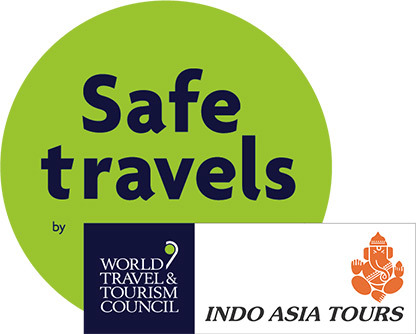 Recognized with the “Safe Travel Stamp”, from WTTC (World Travel and Tourism Council), Indo Asia Tours is aligned with the ‘Safe Travel protocols’, adhering to our responsibilities as a responsible tour operator and have adopted health and hygiene global standardized protocols.
Recognized with the “Safe Travel Stamp”, from WTTC (World Travel and Tourism Council), Indo Asia Tours is aligned with the ‘Safe Travel protocols’, adhering to our responsibilities as a responsible tour operator and have adopted health and hygiene global standardized protocols.
While you and your clients plan a trip with us, let us take you through another momentous journey in the Indian Subcontinent covering “THE ANNAPURNA MASSIF AND FAMOUS TREKS AROUND IT”, in Nepal.
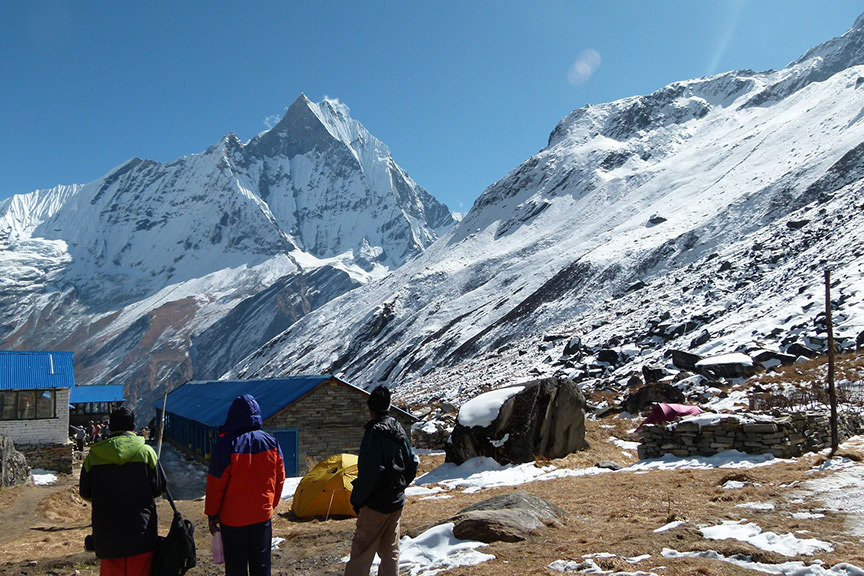
The Annapurna Mountain is named after the Hindu goddess of food and nourishment, Goddess Annapurna. The name Annapurna is derived from the Sanskrit-language words purna ("filled") and anna ("food") and can be translated as "Everlasting Food." It is believed that the Goddess still resides in this massif. Many streams descending from the Annapurna massif slopes provide water for the agricultural fields and meadows located at lower elevations in Nepal, thus making it literally the region's everlasting food provider.
FACTS ABOUT THE ANNAPURNA MASSIF
With one peak reaching over 8,000 meters, thirteen peaks reaching over 7,000 meters, and sixteen more peaks reaching over 6,000 meters, all within a 55-kilometre (or 34 miles) stretch - The Annapurna massif is as epic as one can imagine. Perched in north-central Nepal, the massif is surrounded by Marsyangdi River on the north and east, the Kali Gandaki gorge on the west, and Pokhara valley on the south.

On the western end, this massif encompasses the Annapurna Sanctuary, which is a high basin. The massif’s highest peak is Annapurna I Main, which is the tenth highest mountain globally standing tall at an altitude of 8,091 meters above sea level.
Annapurna Massif is something beyond words; it is a place that one has to see to believe. The first person to conquer this majestic peak was Maurice Herzog. He, in 1950, led a French expedition to its summit through the north face. This was also the first peak beyond 8000 meters, which was successfully climbed. It was also the first peak higher than 8000 meters, which was successfully conquered in the very first attempt. Though many years have passed since then and many have conquered this peak, it is still considered one of the most treacherous mountains to climb.
The whole massif and its surrounding areas are protected in the 7,629-square-kilometre (or 2,946 square miles) Annapurna conservation area. This conservation area is said to be the first and largest conservation area in Nepal.

It is home to around 1,226 species of flowering plants, 474 species of birds, 102 species of mammals, 22 species of amphibians, and 33 species of reptiles along with world-class treks, including some of the most famous treks, such as Annapurna Circuit and Annapurna Sanctuary.
|
Historically speaking, the Annapurna peaks have always been among the most treacherous mountains to climb in the world. This is especially true due to Annapurna I main's extremely steep south face, a wall of rocks that rises 3,000 meters above sea level.
Let’s take a look at some of the popular trekking routes in Annapurna massif:
ANNAPURNA CIRCUIT TREK
It is said that sometimes the old ones are the best! This is true for the Annapurna circuit trek because it is among one of the oldest, most famous and much-loved treks among trekkers.
This trek starts at Lamjung, where one climbs through pretty rice fields that beautifully cover the mountain slopes. The trek further follows the Marsyangdi River through numerous hill villages. As one climb further, leaving the Hindu settlements behind, there will be a change in the surroundings. The temples will be replaced with prayer flags and Mani walls as it is the villages of Buddhist communities.
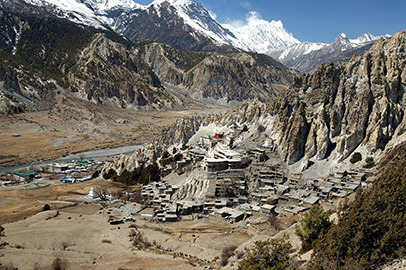 It is advisable to slow down the pace here as altitude sometimes poses a challenge. However, one can use this time to visit the incredible Braka Gompa (monastery) or explore the villages around Manang. Find more about the place in this video.
It is advisable to slow down the pace here as altitude sometimes poses a challenge. However, one can use this time to visit the incredible Braka Gompa (monastery) or explore the villages around Manang. Find more about the place in this video.
Past Manang, one will climb closer to the mountain’s snowy white peaks. This hike will further take to the Thorong La Pass, which is the highest point of this trek. Situated at an altitude of 5,416 meters above sea level it is definitely the most challenging part of the trek. After spending some time, one can start to descend to the temple at Muktinath and enter the Mustang area. The landscape and the people around Mustang are different from what one would have experienced earlier during the trek. The people who dwell around Mustang are called Thakali people.
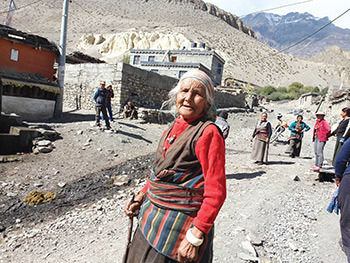 They are some of the most welcoming people who are always enthusiastic to introduce their culture to travellers. At Jomsom, one can have an option to either fly back to Pokhara, or continue trek down along the Kali Gandaki river leading towards Tatopani and up towards Poon Hill.
They are some of the most welcoming people who are always enthusiastic to introduce their culture to travellers. At Jomsom, one can have an option to either fly back to Pokhara, or continue trek down along the Kali Gandaki river leading towards Tatopani and up towards Poon Hill.
The more enthusiasts can continue all the way to the Annapurna Base Camp, to get some of the best and stunning views of Annapurna 1, Annapurna South, and Machhapuchhre or Fishtail Mountain (as it is famously known).
Insider Tip: Before you start your hike to Thorong La, spend at least 2 nights in Manang and do small hikes to allow your body to acclimatize to the high altitude. Upon reaching Manang, try a slice of cake at the village coffee shop or listen to the excellent lecture on altitude, organized every day by the Himalayan Rescue Association.
POON HILL TREK
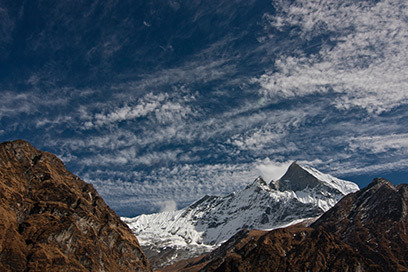
The trekkers with limited time to explore the entire circuit can consider taking the Poon Hill trek. It can be covered between 3 to 5 days, depending upon one’s fitness level. It is said that this trek is one of the most beautiful treks in the region.
The trek offers some really amazing panoramic mountain views of Dhaulagiri, Annapurna I, Machhapuchhre, Nilgiri, Annapurna South, Annapurna II, Annapurna III, Annapurna IV, Lamjung Himal, Hiunchuli, Tukuche Peak, etc. Poon Hill trek is also famous for exploring the historical villages & lifestyles of Magar and Gurung ethnic groups.
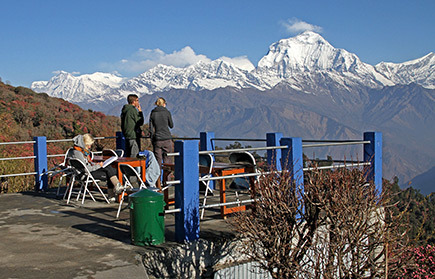 The trek starts
The trek starts from Nayapul, from where the trails gradually ascents to Tikhedunga following the Modi River. After crossing the suspension bridge, one will reach the guesthouse. From there, one needs to continue journey towards Ghorepani, the place for overnight stop. Ghorepani village is said to be one of the busiest Tibetan trade centres where many Tibetan materials can be found displayed in the local market.
Hiking up, one will witness some of the breathtaking views of the peaks in the Annapurna region covered with the thick blanket of snow and the varied views of the sacred mount Fishtail.
Insider Tip: Every day early in the morning and evening, trekkers observe the sunrise & sunset view from Poon hill with a hike of around 40 minutes from Ghorepani. This spot is absolutely amazing and one of the best viewpoints to catch panoramic mountain views.
ANNAPURNA SANCTUARY TREK
Annapurna circuit is among the lengthiest treks, while Poon Hill is considered a short trek. Fortunately, there is one more jewel here in this region i.e. The Annapurna Sanctuary trek - A classic tea house trek.
Like the Poon hill and Annapurna circuit, this trek takes one away from the civilization into the true Himalayan wilderness. The Annapurna sanctuary trek also allows visiting the Annapurna base camp. It is considered ideal for people who have restricted time but want to journey through an exceptional amphitheatre of rocks.

This trek traverses through diverse vegetation. While trekking from Ghandruk to Chomrung, one will be surrounded by some really beautiful fern, rhododendron, and bamboo forests. After hiking past Sinuwa, the Annapurna sanctuary is entered, with much denser forest & tall oak trees. Walking higher up towards Deurali, the dense forests will give way to tall grassland. One will notice that the trees have a thick bark around this area. This thick bark is called Daphne, and it is used to make paper by the locals. Hiking further, one will come close to Machhapuchhre base camp, where the terrain turns alpine with some patches of grass amongst the boulders and beautiful flowering plants lining the trail. Here, the trail has three sections through the forest, which is so dense that sunlight barely passes through it. The first section starts right after crossing the villages around Chomrung and stretches till new bridge. While the trail takes to Sinuwa, one can hear the wild roars of Modi Khola river hidden behind the dense tree cover.
The third and final stretch starts after crossing Bamboo and stretches all the way to Dovan. The most beautiful thing about this trek is the walk through these dense forests, not once but twice!
Insider Tip: One of the best times to do this trek is In October when the views are outstanding.
BEST TIME
It is possible to trek through the Annapurna circuit for most of the year. Just avoid the June-August monsoon season when rivers flood and landslides occur. Autumn (September - November) brings clear skies, plus the bugs and dust have been washed away by the rains. Spring (February - mid April) has warmer, longer days, with the rhododendrons blooming in full-throttle. Lower altitudes can be hazy in May. One can also trek in winter (December – January), but snow often blocks the way thus leading to delays or detours.
While mentioning the famous trekking region in Nepal, one cannot forget about other beautiful aspects this landlocked country has on offer. Be it the beautiful culture, history, wildlife, people and cuisines, a journey into Nepal seems almost cathartic. See what it is really like when you combine soaring peaks with beauty of Nepal in this short video. With us, the itinerary is not just a travel route or a trip. We design, conceptualize and handcraft every journey for you. Our bespoke itineraries and curated experiences in different destinations are what make for those memorable travel moments.
|
Virtual Destination Training Program
|
 Thank you, patrons, for reposing faith in our destinations and enquiring for customised virtual destination awareness training programs. We are proud to conduct them successfully so far and are looking forward to hold similar virtual destination awareness training programs for your team or yourself or a virtual tour for your clients. Let us know the destination of your interest along with your convenient date / time and we will be happy to set up a program for you.
Thank you, patrons, for reposing faith in our destinations and enquiring for customised virtual destination awareness training programs. We are proud to conduct them successfully so far and are looking forward to hold similar virtual destination awareness training programs for your team or yourself or a virtual tour for your clients. Let us know the destination of your interest along with your convenient date / time and we will be happy to set up a program for you.
Send Request
|
Please feel free to write back to us at marketing@indoasiatours.com to share our thoughts on customized journeys covering the Indian subcontinent or take time to visit our website https://www.indoasia-tours.com. Be sure we will prepare the best program to make a memorable trip for your esteemed clients!
|
|

 Recognized with the “Safe Travel Stamp”, from WTTC (World Travel and Tourism Council), Indo Asia Tours is aligned with the ‘Safe Travel protocols’, adhering to our responsibilities as a responsible tour operator and have adopted health and hygiene global standardized protocols.
Recognized with the “Safe Travel Stamp”, from WTTC (World Travel and Tourism Council), Indo Asia Tours is aligned with the ‘Safe Travel protocols’, adhering to our responsibilities as a responsible tour operator and have adopted health and hygiene global standardized protocols.
 On the western end, this massif encompasses the Annapurna Sanctuary, which is a high basin. The massif’s highest peak is Annapurna I Main, which is the tenth highest mountain globally standing tall at an altitude of 8,091 meters above sea level.
On the western end, this massif encompasses the Annapurna Sanctuary, which is a high basin. The massif’s highest peak is Annapurna I Main, which is the tenth highest mountain globally standing tall at an altitude of 8,091 meters above sea level.
 It is home to around 1,226 species of flowering plants, 474 species of birds, 102 species of mammals, 22 species of amphibians, and 33 species of reptiles along with world-class treks, including some of the most famous treks, such as Annapurna Circuit and Annapurna Sanctuary.
It is home to around 1,226 species of flowering plants, 474 species of birds, 102 species of mammals, 22 species of amphibians, and 33 species of reptiles along with world-class treks, including some of the most famous treks, such as Annapurna Circuit and Annapurna Sanctuary.
 It is advisable to slow down the pace here as altitude sometimes poses a challenge. However, one can use this time to visit the incredible Braka Gompa (monastery) or explore the villages around Manang.
It is advisable to slow down the pace here as altitude sometimes poses a challenge. However, one can use this time to visit the incredible Braka Gompa (monastery) or explore the villages around Manang.  They are some of the most welcoming people who are always enthusiastic to introduce their culture to travellers. At Jomsom, one can have an option to either fly back to Pokhara, or continue trek down along the Kali Gandaki river leading towards Tatopani and up towards Poon Hill.
They are some of the most welcoming people who are always enthusiastic to introduce their culture to travellers. At Jomsom, one can have an option to either fly back to Pokhara, or continue trek down along the Kali Gandaki river leading towards Tatopani and up towards Poon Hill.
 The trekkers with limited time to explore the entire circuit can consider taking the Poon Hill trek. It can be covered between 3 to 5 days, depending upon one’s fitness level. It is said that this trek is one of the most beautiful treks in the region.
The trekkers with limited time to explore the entire circuit can consider taking the Poon Hill trek. It can be covered between 3 to 5 days, depending upon one’s fitness level. It is said that this trek is one of the most beautiful treks in the region.
 The trek starts from Nayapul, from where the trails gradually ascents to Tikhedunga following the Modi River. After crossing the suspension bridge, one will reach the guesthouse. From there, one needs to continue journey towards Ghorepani, the place for overnight stop. Ghorepani village is said to be one of the busiest Tibetan trade centres where many Tibetan materials can be found displayed in the local market.
The trek starts from Nayapul, from where the trails gradually ascents to Tikhedunga following the Modi River. After crossing the suspension bridge, one will reach the guesthouse. From there, one needs to continue journey towards Ghorepani, the place for overnight stop. Ghorepani village is said to be one of the busiest Tibetan trade centres where many Tibetan materials can be found displayed in the local market.
 This trek traverses through diverse vegetation. While trekking from Ghandruk to Chomrung, one will be surrounded by some really beautiful fern, rhododendron, and bamboo forests. After hiking past Sinuwa, the Annapurna sanctuary is entered, with much denser forest & tall oak trees. Walking higher up towards Deurali, the dense forests will give way to tall grassland. One will notice that the trees have a thick bark around this area. This thick bark is called Daphne, and it is used to make paper by the locals. Hiking further, one will come close to Machhapuchhre base camp, where the terrain turns alpine with some patches of grass amongst the boulders and beautiful flowering plants lining the trail. Here, the trail has three sections through the forest, which is so dense that sunlight barely passes through it. The first section starts right after crossing the villages around Chomrung and stretches till new bridge. While the trail takes to Sinuwa, one can hear the wild roars of Modi Khola river hidden behind the dense tree cover.
This trek traverses through diverse vegetation. While trekking from Ghandruk to Chomrung, one will be surrounded by some really beautiful fern, rhododendron, and bamboo forests. After hiking past Sinuwa, the Annapurna sanctuary is entered, with much denser forest & tall oak trees. Walking higher up towards Deurali, the dense forests will give way to tall grassland. One will notice that the trees have a thick bark around this area. This thick bark is called Daphne, and it is used to make paper by the locals. Hiking further, one will come close to Machhapuchhre base camp, where the terrain turns alpine with some patches of grass amongst the boulders and beautiful flowering plants lining the trail. Here, the trail has three sections through the forest, which is so dense that sunlight barely passes through it. The first section starts right after crossing the villages around Chomrung and stretches till new bridge. While the trail takes to Sinuwa, one can hear the wild roars of Modi Khola river hidden behind the dense tree cover.
 Thank you, patrons, for reposing faith in our destinations and enquiring for customised virtual destination awareness training programs. We are proud to conduct them successfully so far and are looking forward to hold similar virtual destination awareness training programs for your team or yourself or a virtual tour for your clients. Let us know the destination of your interest along with your convenient date / time and we will be happy to set up a program for you.
Thank you, patrons, for reposing faith in our destinations and enquiring for customised virtual destination awareness training programs. We are proud to conduct them successfully so far and are looking forward to hold similar virtual destination awareness training programs for your team or yourself or a virtual tour for your clients. Let us know the destination of your interest along with your convenient date / time and we will be happy to set up a program for you.





